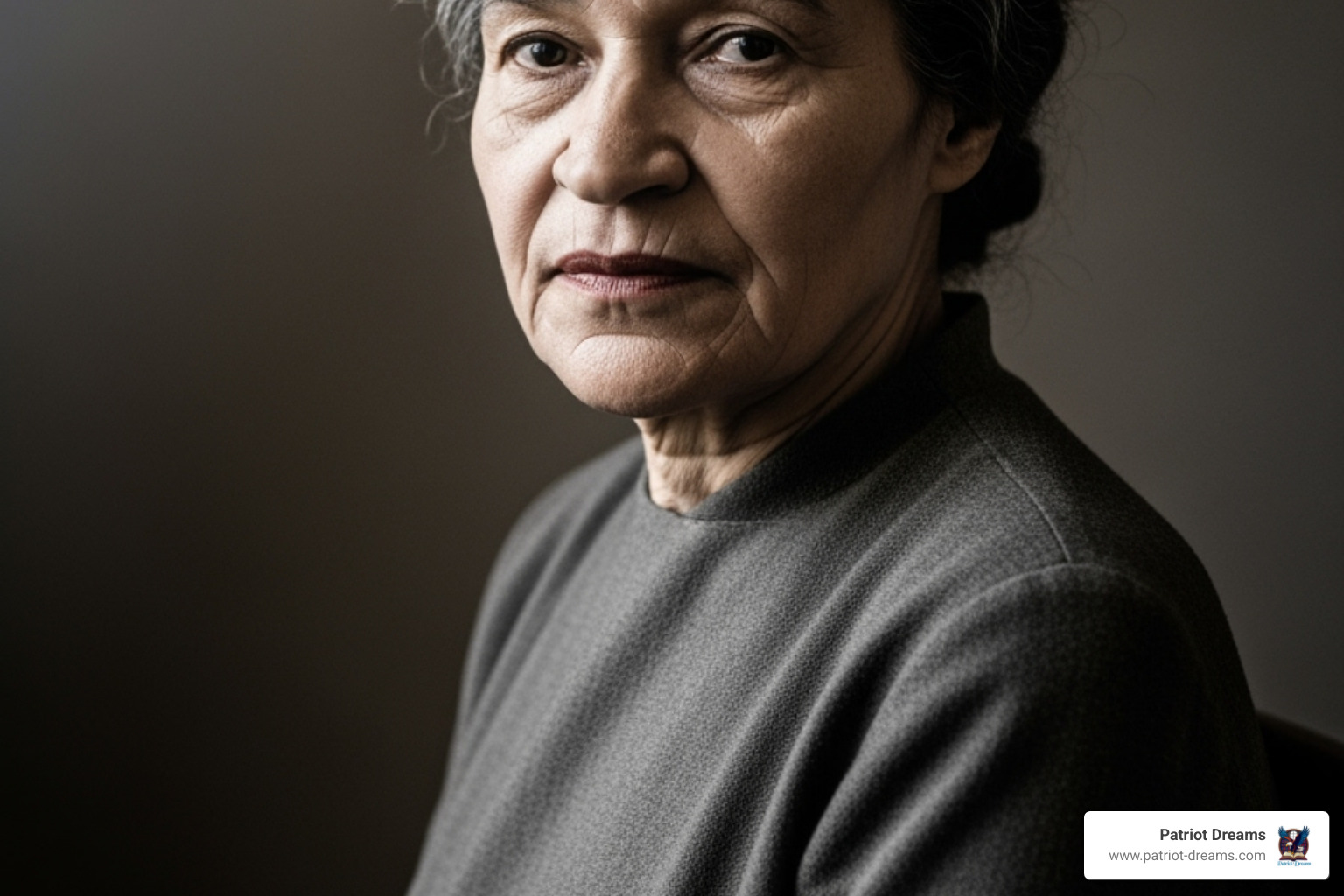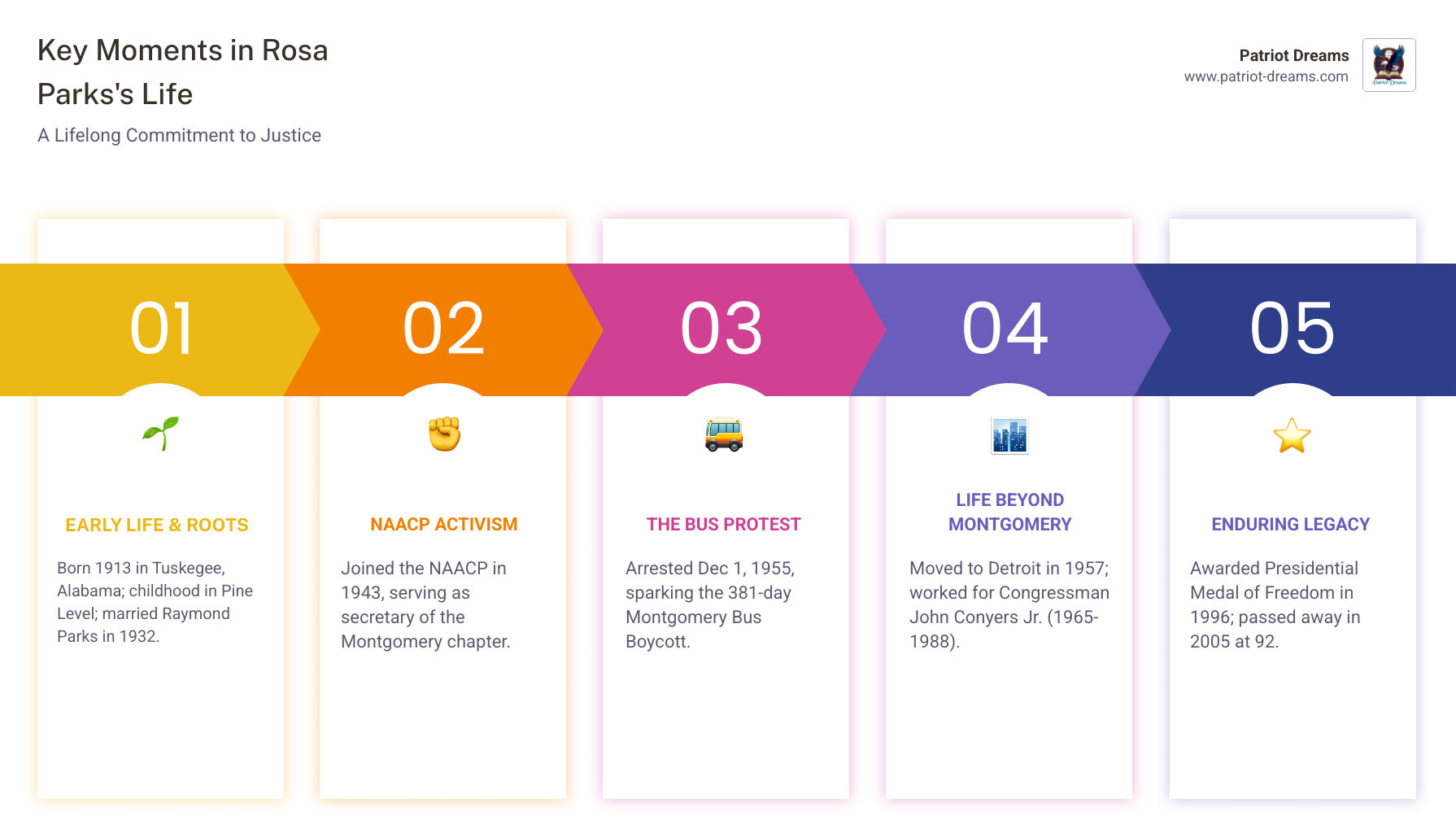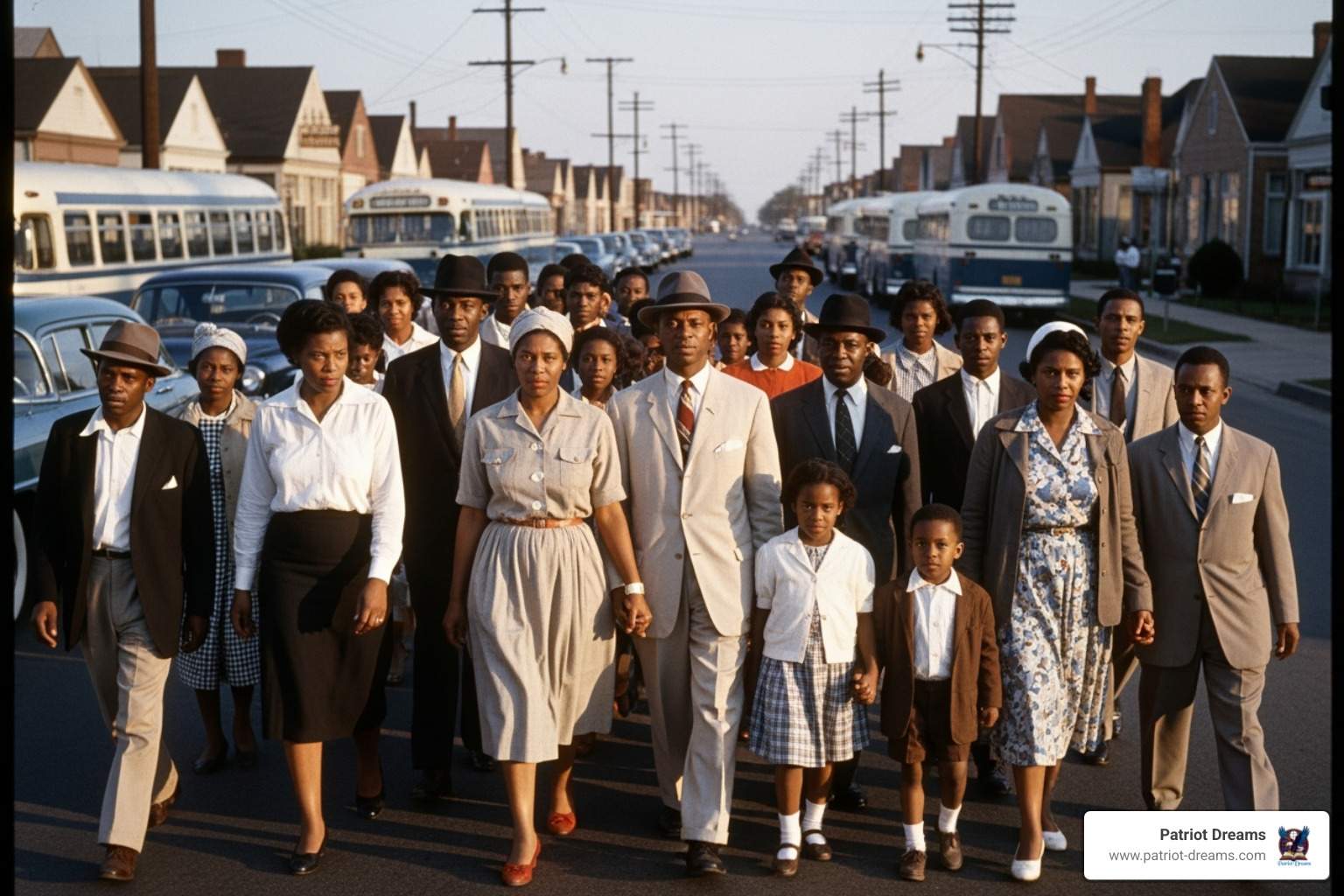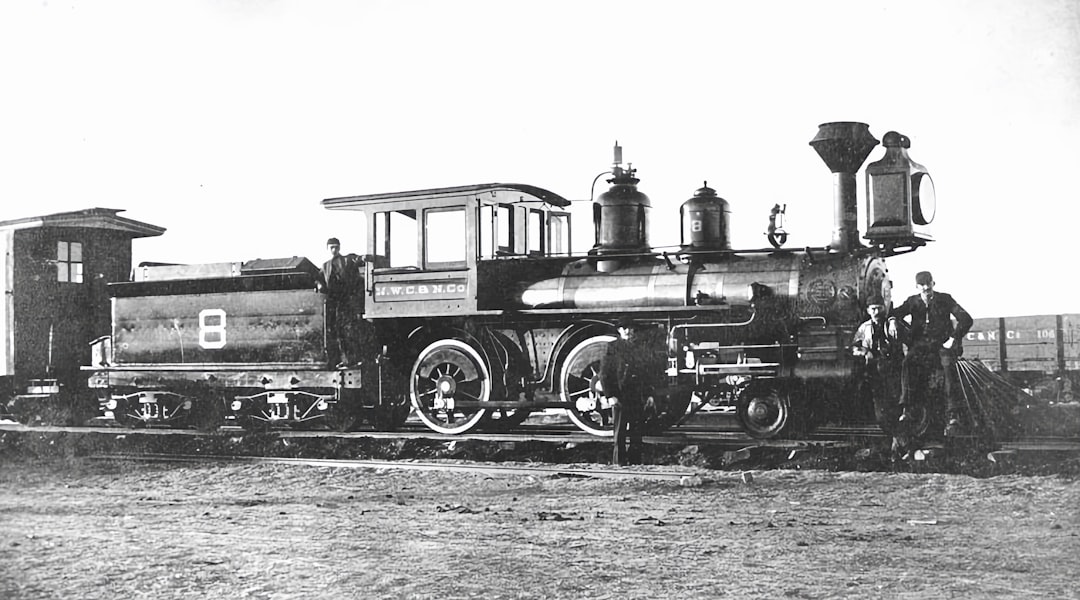Rosa Parks: The Woman Who Sparked a Movement


More Than a Moment on a Bus
The Rosa Parks story isn't just about a tired woman who refused to give up her seat on December 1, 1955. It's the story of a lifelong activist whose quiet courage changed America.
Quick Facts About Rosa Parks:
- Born: February 4, 1913, in Tuskegee, Alabama
- The Famous Moment: Refused to give up her bus seat on December 1, 1955
- Age at Arrest: 42 years old
- What She Said: "I was not tired physically... I was tired of giving in"
- The Result: Sparked the 381-day Montgomery Bus Boycott
- Her Role: Secretary of the Montgomery NAACP chapter since 1943
- Legacy: Known as the "Mother of the Civil Rights Movement"
- Honors: Presidential Medal of Freedom and Congressional Gold Medal
Most people know Rosa Parks as the seamstress who wouldn't move. But that simple description misses the mark on who she really was—a woman of deep faith, quiet strength, and unwavering principles who had fought for justice long before that evening.
Rosa wasn't just physically tired after a long day at work. As she later explained, "I was not tired physically... I was tired of giving in." Her grandfather had taught her to stand up for herself. Her husband Raymond had introduced her to civil rights work. And for twelve years before that famous bus ride, she had served as secretary of the Montgomery NAACP chapter, investigating cases of violence and discrimination.
When Rosa Parks took her seat that evening, she carried the hopes and frustrations of her community. Her story reminds us that true change often comes not from grand gestures, but from ordinary people who decide they've had enough—and have spent years preparing for the moment their quiet "no" becomes a resounding call for justice.

The Heart of a Helper: Rosa's Early Life and Values
Long before the world knew her name, Rosa Louise McCauley was learning the lessons that would shape her. Born on February 4, 1913, in Tuskegee, Alabama, she grew up in the small farming community of Pine Level with her maternal grandparents. As a girl, Rosa was surrounded by love and strength that would carry her through a lifetime of standing up for what's right.
The Rosa Parks story truly begins in those early years, when the values of courage and dignity were planted deep in her heart by the people who loved her most.
A Foundation of Faith and Family
Imagine a young Rosa, sleeping in her clothes on nights when the Ku Klux Klan rode through their community. Her grandfather, born into slavery, would sit by the window with his rifle, watching over his family. These were Rosa's childhood memories, shaping her understanding that you must be brave when the world is frightening.
But Rosa's childhood wasn't defined by fear. Her mother, Leona McCauley, was a teacher who made sure Rosa could read and write beautifully. In a time when many Black children couldn't attend school regularly, Rosa's education was a family priority. She later attended the Montgomery Industrial School for Girls, where she learned to read with passion and developed the strong moral compass that would guide her entire life.
Rosa's family taught her something powerful: you don't have to accept being treated poorly. She later remembered that even as a child, she couldn't accept physical bullying without standing up for herself. Her grandparents' protection and her mother's teaching created a foundation of faith and family that made Rosa believe she deserved respect and dignity.
The young woman who emerged from Pine Level was deeply involved in her church and community involvement came naturally to her. She learned to cook and sew, which were practical skills that would serve her well, but more importantly, she learned that standing up for yourself and others wasn't just acceptable, it was necessary.
Joining a Cause Bigger Than Herself
In 1932, when Rosa was 19, she met Raymond Parks, a barber who would change her life in the most wonderful way. Raymond was already deeply involved in civil rights work and was passionate about justice. Their courtship bloomed around shared values and dreams for a better world.
Meeting Raymond Parks opened Rosa's eyes to organized activism. He encouraged her to finish her high school education in 1933—something remarkable for a Black woman in Alabama at that time. Their marriage became a true partnership built on mutual respect and a shared belief that things could and should be better.
In 1943, Rosa took a step that would define the rest of her life: she joined the NAACP and became secretary of the Montgomery chapter. This wasn't just a title; Rosa worked closely with E.D. Nixon, the chapter president, investigating injustices throughout Alabama.
Her work with the National Association for the Advancement of Colored People included heartbreaking cases like that of Recy Taylor, a Black woman assaulted by white men in 1944. Rosa traveled across Alabama gathering testimony, showing the quiet courage she would later display on the bus.
Rosa also threw herself into voter registration efforts, even though it was an uphill battle. She herself had to try three times before successfully registering to vote in 1945. Her desire for a better world wasn't just a dream. It was work she did every single day.
By the time Rosa Parks stepped onto that bus in 1955, she had spent over a decade fighting for justice. She wasn't just a tired seamstress; she was an experienced activist whose quiet strength had been building for years, ready to say "no" in a way the world would hear.
A Quiet "No" Heard Around the World

The Rosa Parks story that changed America forever began with something as simple as choosing where to sit. But in Montgomery, Alabama, in 1955, even that basic choice was stripped away by the cruel reality of Jim Crow laws. These laws didn't just separate people—they created a daily humiliation that wore down the spirit of an entire community.
Under the Montgomery City Code, buses became rolling symbols of inequality. White passengers claimed the front seats as their exclusive territory, while Black passengers were forced to the back. But the cruelest part? When the white section filled up, bus drivers, who held the power of police officers, could demand that Black riders give up their seats and stand. It was a degrading ritual that happened day after day, reminding people of their supposed "place" in society.
The Day That Changed Everything
Thursday, December 1, 1955, started like any other workday for Rosa Parks. At 42, she had spent a long day at her job as a seamstress at the Montgomery Fair department store. When she boarded the Cleveland Avenue bus that evening, she was thinking about getting home, not making history.
The bus filled up as it always did. When a white passenger needed a seat, bus driver James F. Blake looked toward the first row of the "colored" section and made his familiar demand. Three other Black passengers stood up and moved, as they'd been conditioned to do countless times before.
But Rosa Parks stayed seated.
When Blake asked, "Why don't you stand up?", her response was calm and dignified: "I don't think I should have to stand up." Years later, she would explain the moment perfectly: "People always say that I didn't give up my seat because I was tired, but that isn't true. I was not tired physically... No, the only tired I was, was tired of giving in."
Those words capture something beautiful about the human spirit—that sometimes, we reach a point where our dignity matters more than our comfort or safety.
Blake called the police, and Rosa was arrested for disorderly conduct. She was briefly jailed, then released on bail with the help of E.D. Nixon from the NAACP. Later, she was convicted and fined $14 - $10 for the violation plus $4 in court costs. It seems like such a small amount, but that fine would spark a movement that transformed America. The An Act of Courage, The Arrest Records of Rosa Parks preserve this pivotal moment in our nation's journey toward justice.
Not the First Time: A History of Courage
What makes Rosa's story even more remarkable is that this wasn't her first encounter with James Blake's hostility. Twelve years earlier, in 1943, she had refused to follow his humiliating demand that she re-enter the bus through the back door after paying her fare at the front. Blake had been so angry that day, he grabbed her coat sleeve and forced her off the bus entirely.
Rosa also wasn't the first brave soul to resist bus segregation. Just nine months before her arrest, 15-year-old Claudette Colvin had refused to give up her seat with the same quiet courage. Other remarkable women like Mary Louise Smith, Aurelia Browder, and Susie McDonald had also stood their ground against injustice.
But sometimes, history chooses its moments carefully. The NAACP and civil rights leaders like E.D. Nixon recognized that Rosa Parks possessed something special - what they called "unquestioned honesty and integrity." Her twelve years of dedicated service with the NAACP, her gentle but firm character, and her standing in the community made her the perfect person to challenge an unjust system.
It's beautiful to think about how all those years of quiet service, all those moments of choosing what was right over what was easy, had prepared Rosa for this one transformative moment. Her story reminds us that heroes aren't born overnight. They're shaped by a lifetime of small, brave choices that prepare them for the moment when their courage can light the way for others.
A Community United: The Montgomery Bus Boycott

When Rosa Parks was arrested on that December evening, something beautiful happened in Montgomery. The community that had watched her quiet courage for years was ready to act. The Women's Political Council, led by Jo Ann Robinson, had been preparing for this moment. These dedicated women, along with E.D. Nixon and other community leaders, knew that Rosa's arrest could be the spark they needed.
Within hours, they made a bold decision: Montgomery's Black community would boycott the buses on Monday, December 5, 1955—the day of Rosa's trial. It was an enormous ask. After all, most people depended on those buses to get to work, to shop, to live their daily lives.
How a City Walked for Freedom
What happened next shows the incredible power of a community united by hope and determination. Working through the night, volunteers cranked out 35,000 flyers on mimeograph machines. Many of these notices went home with Black schoolchildren, who carried them to their parents like messengers of change.
The success of that first day was overwhelming. Buses that normally carried thousands of Black passengers rolled through Montgomery nearly empty. The sight of those vacant buses told a story more powerful than any speech. Tthis community had found its voice.
Inspired by this remarkable show of unity, the leaders decided to continue the boycott indefinitely. They formed the Montgomery Improvement Association and chose a young minister named Dr. Martin Luther King Jr. as their president. At just 26 years old, King brought eloquent leadership to a movement that would change America.
For 381 days, the people of Montgomery walked. They organized intricate community carpools that ran like clockwork. Folks walked miles to work each morning and miles back home each evening. Neighbors helped neighbors, strangers became friends, and the whole community finded what they could accomplish together.
The spirit of sacrifice was remarkable. People wore out their shoes walking to work, but they kept walking. When some white employers threatened to fire Black workers who participated, the community found ways to support each other. It was nonviolent protest at its most beautiful: peaceful, determined, and filled with dignity.
Not everyone supported their efforts. Dr. King's home was bombed, as was E.D. Nixon's. Rosa and other boycott leaders were even charged with violating state anti-boycott laws. But rather than breaking their spirit, these attacks only strengthened their resolve and drew national attention to their cause.
A Victory for All: The Legal Battle
While Montgomery's streets filled with walking protesters, another crucial battle was happening in the courtrooms. The community's legal team, building on the foundation laid by Brown v. Board of Education, took their fight to the U.S. District Court. The case, known as Browder v. Gayle, challenged the very idea that bus segregation was constitutional.
As the legal appeals wound their way through the court system, the boycott continued. Each day of walking was both a personal sacrifice and a powerful statement. Finally, on November 13, 1956, the U.S. Supreme Court delivered the news everyone had been hoping for: Montgomery's segregated bus seating was unconstitutional.
The written order arrived in Montgomery on December 20, 1956. After 381 days of extraordinary community solidarity, the Montgomery Bus Boycott officially ended in triumph. It was a victory that belonged to everyone who had walked those miles, organized those carpools, and believed that change was possible.
The Rosa Parks story had become something even more powerful—the story of an entire community that chose to stand together for justice. Their peaceful resistance had dismantled a system that seemed unshakeable, proving that ordinary people, united by shared values and quiet courage, could indeed change the world.
The Complete Rosa Parks Story: A Lifetime of Service

The Montgomery Bus Boycott victory brought hope to millions, but for Rosa Parks personally, it came with a heavy price. She lost her job, and her husband Raymond was fired from his position because his boss didn't want him talking about the case. The couple faced constant harassment and death threats, making it nearly impossible to find work in Montgomery.
By 1957, Rosa and Raymond, along with Rosa's mother, made the difficult decision to leave Alabama for Detroit, where Rosa's brother lived. It was a bittersweet goodbye to the city where they'd fought so hard for change, but sometimes courage means knowing when it's time to start fresh.
The True Rosa Parks Story: Life After the Boycott
Detroit became Rosa's new home, but her heart for justice never changed. The Rosa Parks story didn't end with the bus boycott. In many ways, it was just beginning a new chapter. From 1965 to 1988, she worked as an administrative aide for Congressman John Conyers Jr. in Detroit, focusing on issues close to her heart: housing, education, welfare, and job discrimination.
Rosa remained deeply involved in the Civil Rights Movement throughout the 1960s and beyond. She supported the March on Washington in 1963, participated in Freedom Summer in 1964, and even joined protests against apartheid in South Africa. Her activism evolved with the times; she supported the Black Power movement and advocated for political prisoners, always standing with those who needed a voice.
Education and youth development became Rosa's special passion. In 1987, she co-founded the Rosa and Raymond Parks Institute for Self-Development in Detroit, creating programs to help young people learn about civil rights history while developing their own leadership skills. The institute's "Pathways to Freedom" bus tours took students to important civil rights sites, ensuring the next generation would understand their heritage.
Rosa also shared her story through her writings. Her 1992 autobiography, Rosa Parks: My Story, gave readers an intimate look at her life in the segregated South and her role in the freedom struggle. She followed this with Quiet Strength in 1995, exploring how her deep religious faith had sustained her through decades of activism.
Even in her later years, when Rosa faced financial difficulties and health problems, the community rallied around her, just as she had always rallied around others. Detroit Red Wings owner Mike Ilitch quietly helped with her rent, showing the same quiet generosity that Rosa had embodied her entire life.
A Legacy of Honor and Inspiration
When Rosa Parks passed away on October 24, 2005, at age 92, she was universally beloved as "the Mother of the Civil Rights Movement." Her lifetime of service had touched countless lives and changed the very fabric of American society.
The honors that came her way reflected a grateful nation's recognition of her sacrifice. President Bill Clinton awarded her the Presidential Medal of Freedom in 1996—the highest civilian honor in America. She received the Congressional Gold Medal in 1999, and numerous other awards including the NAACP's highest honor, the Spingarn Medal.
In an extraordinary tribute, Rosa Parks became the first woman and only the second Black person to lie in honor in the rotunda of the U.S. Capitol. An estimated 40,000 people came to pay their respects, a testament to how deeply she had touched the American heart.
Her legacy lives on in countless ways. The Rosa Parks Museum in Montgomery stands at the very spot where she was arrested. Cities across America have named parks, schools, and transit centers in her honor. The U.S. Postal Service released a Rosa Parks Forever stamp in 2013 on what would have been her 100th birthday.
Perhaps President Barack Obama said it best when he unveiled her statue in the Capitol building: "In a single moment, with the simplest of gestures, she helped change America and change the world." As Secretary of State Condoleezza Rice once reflected, without Mrs. Parks' courage, her own achievements might never have been possible.
Rosa Parks showed us that one person's quiet dignity can indeed change the world, and that true heroism often comes not from grand gestures, but from the steady, faithful commitment to doing what's right, day after day, year after year.
Frequently Asked Questions about Rosa Parks's Life
Was Rosa Parks the first person to refuse to give up her seat?
This is one of the most common questions people ask about the Rosa Parks story, and it's a wonderful opportunity to understand the broader context of her courage. Rosa wasn't the first person to resist bus segregation. Others had stood up before her, including the remarkably brave 15-year-old Claudette Colvin just nine months earlier.
What made Rosa Parks different wasn't that she was first, but that she was ready. Her impeccable character, her years of experience as secretary of the Montgomery NAACP chapter, and her deep roots in the community made her the ideal person for civil rights leaders to rally behind. E.D. Nixon and other organizers had been waiting for someone of "unquestioned integrity" to become the face of their legal challenge.
Rosa's case became the spark that the community was prepared to fan into a flame. Her calm, dignified demeanor and long history of activism made her the perfect symbol for a movement that was finally ready to take its stand.
Why is the Rosa Parks story so important today?
The Rosa Parks story continues to touch hearts because it reminds us of something beautiful about human nature—that one person's quiet courage, rooted in dignity and deep conviction, can inspire an entire community to change the world.
Her story isn't just about buses or segregation laws. It's about something much more universal: how ordinary people, when they decide to stand together for what's right, can achieve absolutely extraordinary things. Rosa showed us the incredible power of peaceful resistance and the importance of never giving up on the dream of equality and fairness for everyone.
In our world today, her story still encourages us to recognize injustice when we see it and to have the courage to speak up. It's a gentle reminder that we all have the power to make a difference, even when it feels like we're just one small voice.
What is the main lesson from Rosa Parks's life?
The most beautiful lesson from Rosa's life is about quiet strength and lifelong dedication. Too often, people think her story is just about one dramatic moment on a bus. But the truth is so much richer than that.
Rosa's activism didn't start on December 1, 1955, and it certainly didn't end there. She had been fighting for justice for over a decade before that famous evening, and she continued her work for civil rights until the very end of her life. Her story teaches us that real, lasting change doesn't come from a single moment of drama. It comes from years and years of showing up, staying committed, and never losing sight of what's right.
Perhaps most importantly, Rosa's life shows us the power of perseverance rooted in principle. She knew in her heart what was right, and she had the courage to stand by those convictions even when it was difficult, even when it cost her personally. That's a lesson that speaks to every generation—about having the strength to do what's right, not because it's easy, but because it's necessary.
Conclusion: The Enduring Light of a Gentle Hero
When we look back at the Rosa Parks story, we see something beautiful and profound—a life lived with quiet dignity and unwavering principle. She wasn't just a tired woman on a bus that December evening in 1955. She was a lifelong activist whose gentle strength had been building for decades, whose simple "no" carried the weight of an entire community's hopes and dreams.
Rosa Parks embodied what she herself described as being "tired of giving in." Her refusal to move wasn't born from physical exhaustion, but from a deep well of conviction that had been nurtured by loving grandparents, strengthened through years of NAACP work, and refined by a lifetime of quiet service to others. In that one moment, she became the voice for countless people who had endured too much for too long.
What makes her story so enduring is how it reminds us of the strength found in community. Rosa didn't change America alone—she sparked something that was already waiting in the hearts of her neighbors. For 381 days, an entire city walked together, carpooled together, and sacrificed together. They showed us that when ordinary people stand up for what's right, extraordinary things happen.
The profound impact of Rosa's courageous heart continues to ripple through our nation today. Her story teaches us that each of us, no matter how quiet or ordinary we might feel, has the power to make a difference. We can stand up for kindness. We can choose dignity over convenience. We can be part of building a more just and caring world.
At Patriot Dreams, we believe these powerful stories of American courage and community deserve to be preserved and shared. They remind us of who we can be at our best—people who care for one another, who stand together for what's right, and who never give up on the promise of a better tomorrow. Rosa Parks's gentle heroism lights the way forward, showing us that the most powerful changes often begin with the quietest voices.
Explore more inspiring American stories that celebrate the everyday heroes who shaped our nation's heart.
Join the Patriot Dreams Community
Download the app today and start your journey through American history and personal legacy.

Explore Our Latest Insights
Dive into stories that shape our American legacy.



